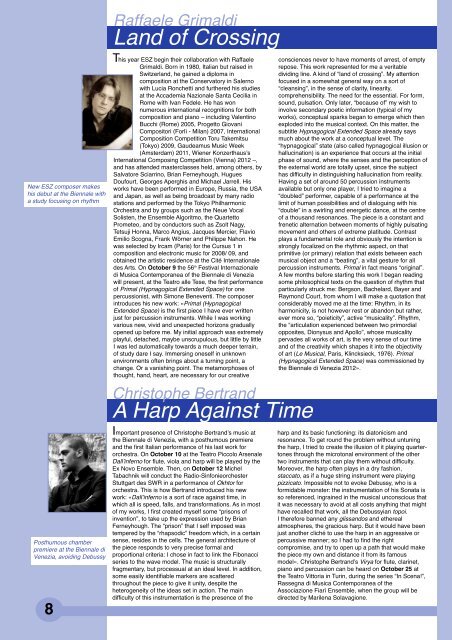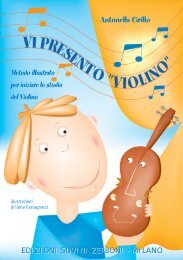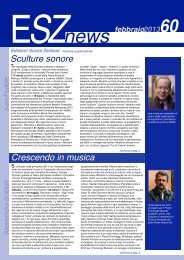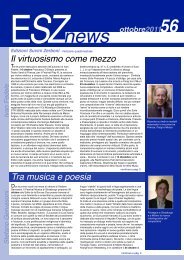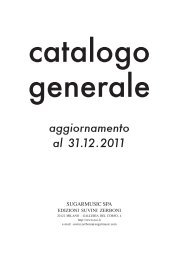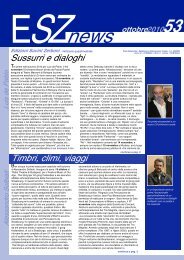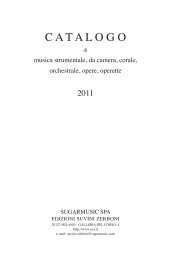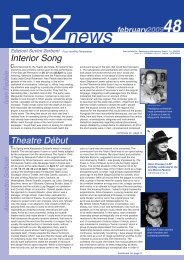Timbral Spaces Sound Labyrinths - Edizioni Suvini Zerboni
Timbral Spaces Sound Labyrinths - Edizioni Suvini Zerboni
Timbral Spaces Sound Labyrinths - Edizioni Suvini Zerboni
You also want an ePaper? Increase the reach of your titles
YUMPU automatically turns print PDFs into web optimized ePapers that Google loves.
New ESZ composer makes<br />
his debut at the Biennale with<br />
a study focusing on rhythm<br />
Posthumous chamber<br />
premiere at the Biennale di<br />
Venezia, avoiding Debussy<br />
8<br />
Raffaele Grimaldi<br />
Land of Crossing<br />
T<br />
his year ESZ begin their collaboration with Raffaele<br />
Grimaldi. Born in 1980, Italian but raised in<br />
Switzerland, he gained a diploma in<br />
composition at the Conservatory in Salerno<br />
with Lucia Ronchetti and furthered his studies<br />
at the Accademia Nazionale Santa Cecilia in<br />
Rome with Ivan Fedele. He has won<br />
numerous international recognitions for both<br />
composition and piano – including Valentino<br />
Bucchi (Rome) 2005, Progetto Giovani<br />
Compositori (Forlì - Milan) 2007, International<br />
Composition Competition Toru Takemitsu<br />
(Tokyo) 2009, Gaudeamus Music Week<br />
(Amsterdam) 2011, Wiener Konzerthaus’s<br />
International Composing Competition (Vienna) 2012 –,<br />
and has attended masterclasses held, among others, by<br />
Salvatore Sciarrino, Brian Ferneyhough, Hugues<br />
Doufourt, Georges Aperghis and Michael Jarrell. His<br />
works have been performed in Europe, Russia, the USA<br />
and Japan, as well as being broadcast by many radio<br />
stations and performed by the Tokyo Philharmonic<br />
Orchestra and by groups such as the Neue Vocal<br />
Solisten, the Ensemble Algoritmo, the Quartetto<br />
Prometeo, and by conductors such as Zsolt Nagy,<br />
Tetsuji Honna, Marco Angius, Jacques Mercier, Flavio<br />
Emilio Scogna, Frank Wörner and Philippe Nahon. He<br />
was selected by Ircam (Paris) for the Cursus 1 in<br />
composition and electronic music for 2008/ 09, and<br />
obtained the artistic residence at the Cité Internationale<br />
des Arts. On October 9 the 56th Festival Internazionale<br />
di Musica Contemporanea of the Biennale di Venezia<br />
will present, at the Teatro alle Tese, the first performance<br />
of Primal (Hypnagogical Extended Space) for one<br />
percussionist, with Simone Beneventi. The composer<br />
introduces his new work: «Primal (Hypnagogical<br />
Extended Space) is the first piece I have ever written<br />
just for percussion instruments. While I was working<br />
various new, vivid and unexpected horizons gradually<br />
opened up before me. My initial approach was extremely<br />
playful, detached, maybe unscrupulous, but little by little<br />
I was led automatically towards a much deeper terrain,<br />
of study dare I say. Immersing oneself in unknown<br />
environments often brings about a turning point, a<br />
change. Or a vanishing point. The metamorphoses of<br />
thought, hand, heart, are necessary for our creative<br />
Christophe Bertrand<br />
A Harp Against Time<br />
I<br />
mportant presence of Christophe Bertrand’s music at<br />
the Biennale di Venezia, with a posthumous premiere<br />
and the first Italian performance of his last work for<br />
orchestra. On October 10 at the Teatro Piccolo Arsenale<br />
Dall’inferno for flute, viola and harp will be played by the<br />
Ex Novo Ensemble. Then, on October 12 Michel<br />
Tabachnik will conduct the Radio-Sinfonieorchester<br />
Stuttgart des SWR in a performance of Okhtor for<br />
orchestra. This is how Bertrand introduced his new<br />
work: «Dall’inferno is a sort of race against time, in<br />
which all is speed, falls, and transformations. As in most<br />
of my works, I first created myself some “prisons of<br />
invention”, to take up the expression used by Brian<br />
Ferneyhough. The “prison” that I self imposed was<br />
tempered by the “rhapsodic” freedom which, in a certain<br />
sense, resides in the cells. The general architecture of<br />
the piece responds to very precise formal and<br />
proportional criteria: I chose in fact to link the Fibonacci<br />
series to the wave model. The music is structurally<br />
fragmentary, but processual at an ideal level. In addition,<br />
some easily identifiable markers are scattered<br />
throughout the piece to give it unity, despite the<br />
heterogeneity of the ideas set in action. The main<br />
difficulty of this instrumentation is the presence of the<br />
consciences never to have moments of arrest, of empty<br />
repose. This work represented for me a veritable<br />
dividing line. A kind of “land of crossing”. My attention<br />
focused in a somewhat general way on a sort of<br />
“cleansing”, in the sense of clarity, linearity,<br />
comprehensibility. The need for the essential. For form,<br />
sound, pulsation. Only later, “because of” my wish to<br />
involve secondary poetic information (typical of my<br />
works), conceptual sparks began to emerge which then<br />
exploded into the musical context. On this matter, the<br />
subtitle Hypnagogical Extended Space already says<br />
much about the work at a conceptual level. The<br />
“hypnagogical” state (also called hypnagogical illusion or<br />
hallucination) is an experience that occurs at the initial<br />
phase of sound, where the senses and the perception of<br />
the external world are totally upset, since the subject<br />
has difficulty in distinguishing hallucination from reality.<br />
Having a set of around 50 percussion instruments<br />
available but only one player, I tried to imagine a<br />
“doubled” performer, capable of a performance at the<br />
limit of human possibilities and of dialoguing with his<br />
“double” in a swirling and energetic dance, at the centre<br />
of a thousand resonances. The piece is a constant and<br />
frenetic alternation between moments of highly pulsating<br />
movement and others of extreme platitude. Contrast<br />
plays a fundamental role and obviously the intention is<br />
strongly focalized on the rhythmic aspect, on that<br />
primitive (or primary) relation that exists between each<br />
musical object and a “beating”, a vital gesture for all<br />
percussion instruments. Primal in fact means “original”.<br />
A few months before starting this work I began reading<br />
some philosophical texts on the question of rhythm that<br />
particularly struck me: Bergson, Bachelard, Bayer and<br />
Raymond Court, from whom I will make a quotation that<br />
considerably moved me at the time: Rhythm, in its<br />
harmonicity, is not however rest or abandon but rather,<br />
ever more so, “poieticity”, active “musicality”. Rhythm,<br />
the “articulation experienced between two primordial<br />
opposites, Dionysus and Apollo”, whose musicality<br />
pervades all works of art, is the very sense of our time<br />
and of the creativity which shapes it into the objectivity<br />
of art (Le Musical, Paris, Klincksieck, 1976). Primal<br />
(Hypnagogical Extended Space) was commissioned by<br />
the Biennale di Venezia 2012».<br />
harp and its basic functioning: its diatonicism and<br />
resonance. To get round the problem without untuning<br />
the harp, I tried to create the illusion of it playing quartertones<br />
through the microtonal environment of the other<br />
two instruments that can play them without difficulty.<br />
Moreover, the harp often plays in a dry fashion,<br />
staccato, as if a huge string instrument were playing<br />
pizzicato. Impossible not to evoke Debussy, who is a<br />
formidable monster: the instrumentation of his Sonata is<br />
so referenced, ingrained in the musical unconscious that<br />
it was necessary to avoid at all costs anything that might<br />
have recalled that work, all the Debussyian topoi.<br />
I therefore banned any glissandos and ethereal<br />
atmospheres, the gracious harp. But it would have been<br />
just another cliché to use the harp in an aggressive or<br />
percussive manner; so I had to find the right<br />
compromise, and try to open up a path that would make<br />
the piece my own and distance it from its famous<br />
model». Christophe Bertrand’s Virya for flute, clarinet,<br />
piano and percussion can be heard on October 25 at<br />
the Teatro Vittoria in Turin, during the series “In Scena!”,<br />
Rassegna di Musica Contemporanea of the<br />
Associazione Fiarì Ensemble, when the group will be<br />
directed by Marilena Solavagione.


